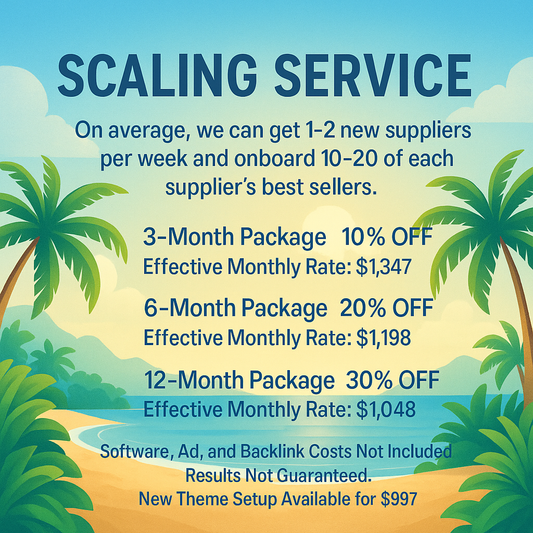
Boost High-Ticket Sales with Data Analytics
Frequently Asked Questions
1. What is high-ticket ecommerce?
2. How does data analytics enhance high-ticket sales?
3. What are some effective methods for collecting data in ecommerce?
4. Why is monitoring performance metrics important in high-ticket ecommerce?
5. What future trends should high-ticket dropshippers consider in data analytics?
Welcome to Ecommerce Paradise! I’m Trevor Fenner, the founder, and today we’re diving into the world of data analytics and its transformative power in enhancing high-ticket sales. If you’re in the ecommerce space—particularly in high-ticket dropshipping—you know how essential it is to make informed decisions that drive profit. In this blog, I'll guide you through how leveraging data can dramatically impact your success in high-ticket ecommerce. Buckle up; it’s going to be an enlightening ride!
Understanding High-Ticket Ecommerce
Before we can delve into data analytics, let’s clarify what we mean by high-ticket ecommerce. High-ticket items are products that are generally sold at a premium price point, often ranging from $500 to several thousand dollars. This could include luxury goods, high-end electronics, or specialized equipment.
High-ticket drop shipping takes this concept further by allowing you to sell these expensive products without holding inventory. Instead, you partner with suppliers who ship directly to your customers. This model can be very lucrative when executed correctly, and data analytics plays a pivotal role in optimizing your strategies.
The Power of Data Analytics
Data analytics is the process of examining data sets to draw conclusions about the information they contain. In the realm of ecommerce, this involves analyzing customer behavior, market trends, and sales data to make evidence-based decisions. In short, it's the compass guiding you through the vast sea of high-ticket ecommerce.
Why Data Matters
Let’s cut to the chase—data matters because it leads to informed decision-making. When you analyze data effectively, you can:
- Identify Customer Preferences: What do customers love? What features are they looking for? Understanding this can help you tailor your offerings.
- Optimize Pricing Strategies: Dynamic pricing can be informed through data to ensure your prices are competitive yet profitable.
- Enhance Marketing Efforts: Analytics help you pinpoint which channels yield the best ROI, allowing you to maximize your marketing budget.
- Improve Customer Experience: By understanding customer behavior, you can streamline the purchasing journey and reduce cart abandonment.
Collecting Data Effectively
Now that we understand the importance of data, how do we go about collecting it effectively? The good news is that ecommerce platforms, including Shopify, offer a wealth of built-in tools and integrations that make data collection straightforward. Here are some key methods:
Website Analytics
Tools like Google Analytics provide invaluable insights into visitor behavior, traffic sources, and page performance. Keep an eye out for metrics such as:
- Conversion Rates: The percentage of visitors making purchases can highlight strong and weak areas of your website.
- Bounce Rates: If users are leaving your page quickly, it might indicate that your site isn’t engaging enough.
- User Flow: Understanding how users navigate through your site can help identify friction points in the purchasing process.
Customer Feedback and Surveys
Don’t underestimate the value of direct feedback! Engaging your customers through surveys or feedback forms can provide information on their preferences and experiences. Ask open-ended questions to gain insight into what they love and what could improve.
Social Media Insights
Social media platforms have native analytics tools that enable you to monitor engagement and demographic information for your followers. Use this data to tailor your marketing strategies, as you can directly connect with your audience's interests.
Data-Driven Decision Making
Once you've gathered sufficient data, the next step is to utilize it for decision-making. Here’s how you can do that in the high-ticket ecommerce space:
Product Selection
The data is your best friend here. Analyze what high-ticket items are performing well in your niche. Which products are trending? Are there seasonal fluctuations you should be aware of? By understanding these aspects, you can select a product range that meets market demand.
Enhancing Marketing Campaigns
Marketing is crucial for high-ticket dropshipping. Leverage data to segment your audience and run targeted campaigns. For instance, if you find that a certain demographic is more likely to purchase luxury items, consider tailoring your ad creatives and messages to appeal directly to that group.
Personalization and Customer Retention
Personalized marketing can significantly enhance customer retention rates. Utilize past purchase data and browsing histories to send tailored recommendations. Remember, high-ticket sales often involve a more extended consideration period; the more you can connect with your customers, the better.
Monitoring and Optimizing Performance
Data analytics isn’t a one-off task; it's an ongoing process. Regularly monitoring your metrics will allow you to make necessary adjustments. Here are essential areas to focus on:
Sales Metrics
Keep a close eye on your sales trends, including which products are flying off the virtual shelves and which are gathering dust. Trending products can indicate market demand while poor performers may need revisiting in terms of pricing, presentation, or marketing strategies.
Customer Acquisition Costs
Understanding how much you're spending to attract new customers versus the revenue they generate is crucial. High-ticket sales might have a higher acquisition cost, but if your lifetime value of a customer compensates for that, each sale becomes highly profitable.
Return on Investment (ROI)
Analyze your marketing channels by calculating ROI to see which methods yield the best results. This ensures that you're investing your budget where it counts the most, maximizing your profits in the competitive high-ticket ecommerce landscape.
The Future of High-Ticket Dropshipping
As technology evolves, so do the tools available for data analytics. Emerging technologies like artificial intelligence and machine learning provide even deeper insights into customer behavior, enabling more predictive analytics. As an ecommerce entrepreneur, staying ahead of these trends can help you tailor your strategies for better outcomes.
Embracing Automation
Automation tools can also assist in collecting and analyzing data. You can set up alerts for when your sales hit certain thresholds or if key metrics, like bounce rates, drop suddenly. This proactive approach allows you to address potential issues before they escalate.
Building Affinity Through Community
In addition to using data analytics for sales, consider fostering a community around your brand. Encourage customer interaction through forums and social media, allowing you to gather qualitative data, which is just as valuable as the quantitative data analytics provide.
Final Thoughts: Unlocking Your High-Ticket Success
High-ticket ecommerce through dropshipping represents a fantastic opportunity, but the journey requires careful navigation. By effectively utilizing data analytics, you can gain insights that allow you to optimize your strategies, refining your offerings and boosting your sales. Remember, data isn’t just numbers—it tells the story of your customers, and understanding that story is key to making high-ticket sales soar!
If you’re excited about using data to elevate your business, join us at Ecommerce Paradise for more tips and insights tailored to your ecommerce journey. Here’s to your success in high-ticket dropshipping!


















